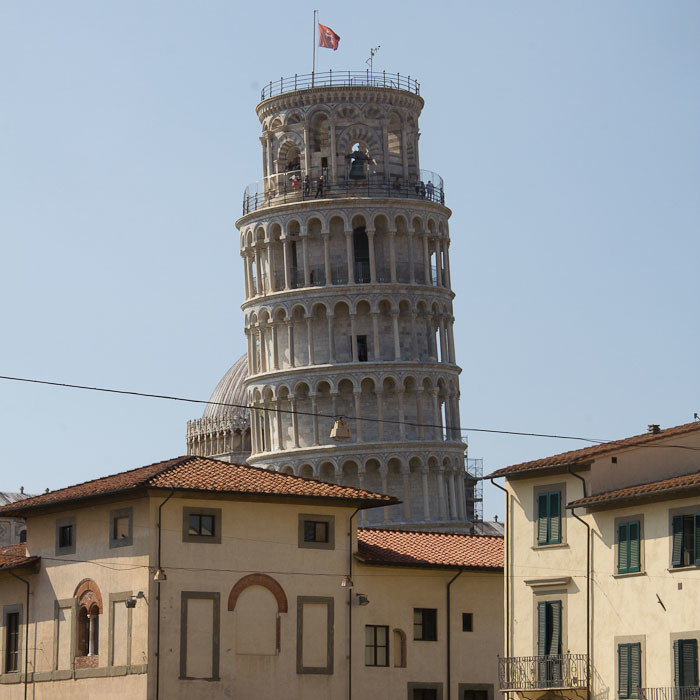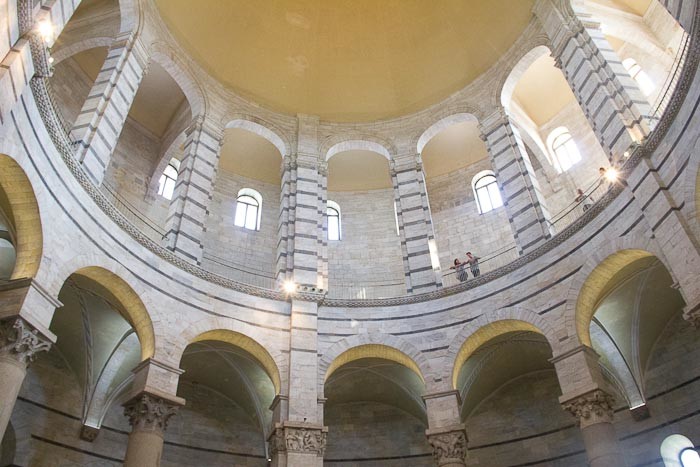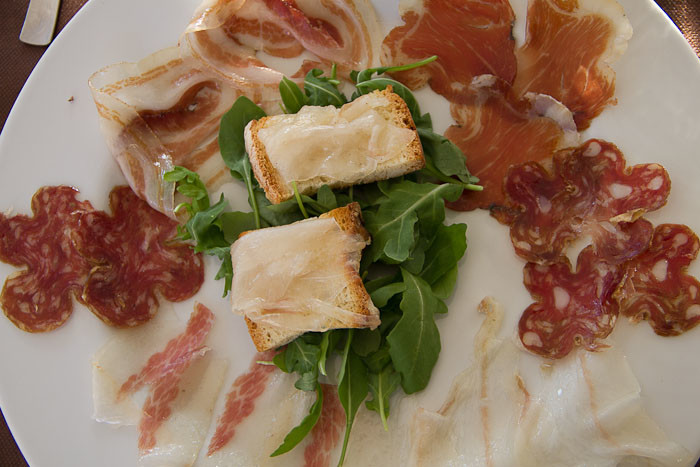Pisa — Not, Actually, Horrid at All
Bologna is almost entirely shut for Ferragosto, AKA August. So, rather envious of the Italian approach to life, with its six week vacations, four hour lunchbreaks and all, we resolve to come back when Bologna’s actually open and head to Pisa instead.
Why? Well, for the Leaning Tower, obviously. And, in particular, to get that picture postcard shot of the boy holding it up (for the ultimate selection of said shots, do pop over to Capturing La Vita, who did it so much better than I…).
The boy, in the way of the boy, is less than enthusiastic about the Leaning Tower. He considers it touristy. In which he is, of course, right.
The Piazza dei Miracoli, home of the Leaning Tower, as well as the Baptistery, the Duomo and the Churchyard, is a seething mass of tourists and tat shops – like the Forbidden City during Golden Week, except with Italian tour guides sporting headsets instead of Chinese tour guides brandishing whistles, and without the military to maintain order.
Visitor after visitor is balanced on the railings, pretending to hold the tower up. We can barely squeeze ourselves in.
And, unlike the last time I visited, when the tower was a) unfenced b) unrepaired c) free to climb and d) open to all ages – oh carefree days before health and safety, when you could take a small child to the edge of a downward-sloping drop five storeys high and not even contemplate suing if it tumbled to its death – it’s going to cost the price of a carpaccio at Harry’s Bar to climb it.
We resolve, instead, that we’ll look at it from outside. Weirdly, I find it more impressive seen from outside the square, its oddity truly revealed in the manner of the Pyramids emerging from the skyscrapers of suburban Cairo, than in its natural context.

I’ve decided that we’ll spend the night in Pisa. Most of the crowds are daytrippers, who evanesce ahead of nightfall. The town itself, wrapped in cypress-lined walls, stretches along the Arno very prettily, and we’ve lucked out in the Agoda lottery with a room in a seventeenth century converted convent for under 50 euros.
The sheer diversity of Italian cities is one of the great things about the country. Italy grew up as a collection of savagely feuding city states, and was only unified in the nineteenth century – in fact there’s even a Tuscan independence movement today.
So tiny little places like Pisa – whose population doesn’t break six figures even today — are home to splendidly grandiose monuments, legendary works of art and their very own culinary specialities.
And, no, when you think about Italian history, it’s probably not a good idea to think about the peasants whose short, hard lives funded these effusive religious monuments, or the poor sods who laboured over decades in brutal conditions to erect them.
But I just did. Dayum…

Anywise, there are several grandiose monuments in Pisa. And, weirdly, lots of the daytrippers seem not to go into them at all.
We start with the Baptistery, where the teen side of the boy is super-pleased to find the font where Galileo Galilei, who he considers an icon, as an atheist, was baptised. His pre-teen side, meanwhile, appreciates the whispering gallery up top.
I’m just gobsmacked by the flawless Romanesque architecture. In a country studded with beautiful buildings, the Baptistery’s one of the prettiest I’ve seen: seamlessly symmetrical octagonal white marble, with a muted elegance that makes me think more mosque than church.
In high season, in the heart of Pisa, there are precisely five other people in there with us.
Church fatigue is almost inevitable in Italy, and I’ve really been trying to keep our church quota to the absolute minimum (after Egypt, Jordan, Lebanon and Israel, the boy is pretty well off “ruins” for good, and I can feel that churches won’t be far behind).
Still, we amble around the Duomo, wondering how on earth Pisa could ever have filled a space this size, and check out the churchyard, a splendid, if rather sterile, affair encased in chilling white walls.
A quick gelato, and then back to base until the crowds die away.

As a general travel principle, any food sold within a hundred metres of an international tourist attraction is almost guaranteed to be over-priced and under-par.
Still, as all the Pisan food places listed in Osterie d’Italia, Italy’s foodie bible, are shut for August, I ask our host for a recommendation. He proffers both a discount and directions to the ominously named Il Toscano.
“Do they have trippa alla Pisana?” I ask. I’ve done my research, and I’m keen to try a local speciality.
“It’s tipico,” he says, utilising that untranslateable Italian term that means both “local” and “good”, but ducking my tripe request.
And, boy, is it tipico. The boy starts with carpaccio, made from a specifically Pisan cow, neatly alternating slices of veal and slices of beef; I go for antipasti, made from the Cinta di Senese, a medieval Tuscan pig that’s returning to fashion.
Zac defaults to his current favourite dish, steak in balsamic sauce, and I devour wild boar in a spicy ragu, swirled on polenta cooked to the consistency of potato puree.
And then we head out to the darkened square where the Leaning Tower, the Duomo, the Baptistery and the Churchyard are delicately illuminated against an aquamarine sky, and Zac poses for a pushing-the-tower photo.
“I wonder,” I say, “Whether we should stay in Italy a bit longer.”
“Hell’s yeah,” says the boy. And so, we downgrade Barcelona to plan B if Egypt has turned into something out of 28 Weeks Later, and prepare for our little Italian road trip.

A beautiful reflection of the side of Pisa not as many get to see.
Thank you!
I’m guilty of being a day-tripper who went to see the Tower and left soon thereafter. But I was only 16 and on a class trip, so I’ve cut myself some slack. The husband and I are currently dream-planning our upcoming European travels and I think an overnight in Pisa is in order!
It’s genuinely very, very magical at night. I was too lazy to walk the old walls, or do much of a stroll up the Arno, but it definitely merits a proper stay.
Ah Pisa! I remember spending the night there when I was 18 and how empty the streets were. I quite liked that city! And the Battistero!! Wow!
It is SUCH a wow, isn’t it? Really knocked me backwards. And even Zac, with church fatigue, was impressed by it…
Well put Theodora. I had a similar experience when I first visited with my 8 and 10 yr olds.
Working past the tourist shock you can see Pisa for what it is and I must say going up the tower was one of the weirdest things. have been back twice since during my annual visits to Reggio Emilia the past 20 yrs
I’m glad you liked it too!
I’m planning a little Italian train-trip (Venice-Florence/Pisa-Rome) for next year so this is very useful! I’ve only ever been to the Alps in Italy so don’t have any experience of the main cities. How is the pricing of things like food, cigarettes, museums etc.? And did it feel safe? – we’ll all be 17 when we go.
This post has made me extremely excited!
Hi Owen! What an adventure. Yes, Italy’s very safe — the only real crime issue most tourists experience are pickpockets, so you need to watch out at train stations if anyone offers to help you with anything (it’s a diversionary tactic while they go into your wallet). Cigarettes are cheaper then Blighty; food varies widely depending on how touristy the area is, but if you eat in local cafe bars and shop at supermarkets you can eat well for 10-12 euros a day. For state-owned museums and historical sites, under-18s get in free – http://www.uffizi.org/1183-finally-kids-are-the-same-for-italian-state-museums/ – although note that not everything’s state-owned.
Almost licked the screen…! Yummy.
Oooh it was, it was. The amazing thing about Italy is how little really good food can cost — even in somewhere like Pisa.